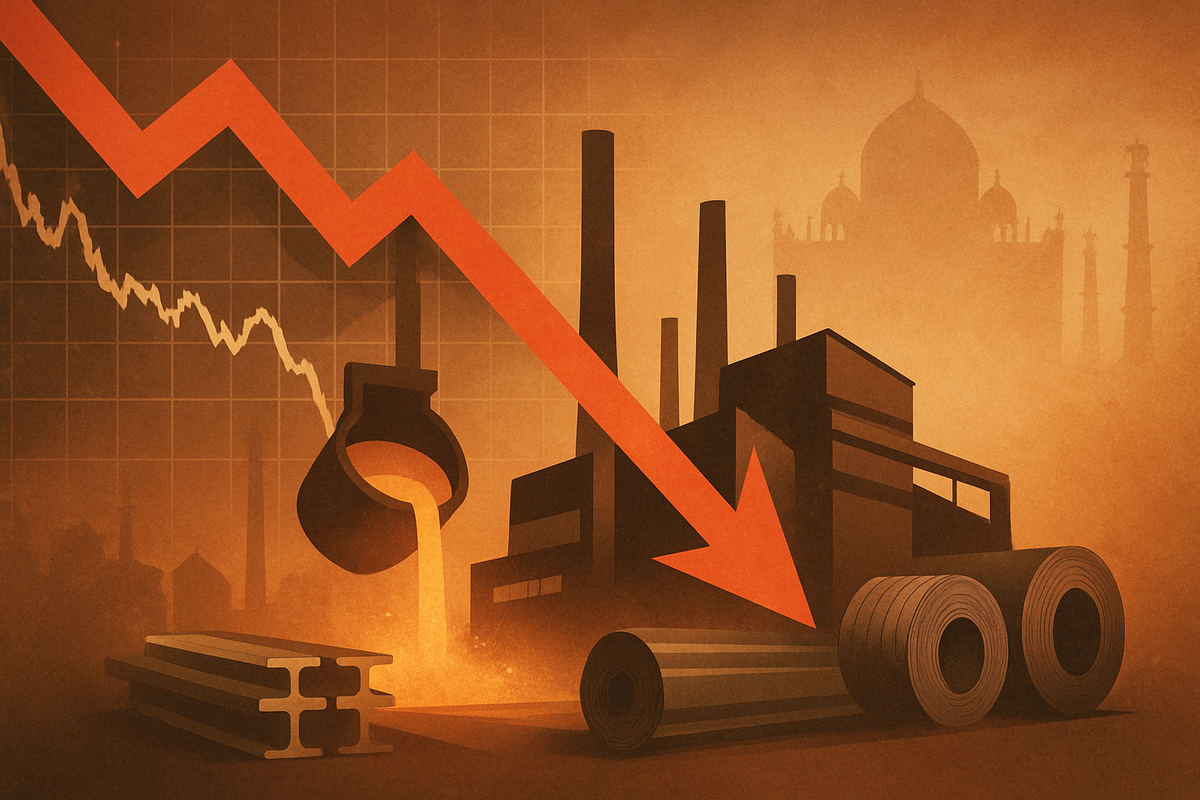
Mumbai, India – September 30, 2025 – Today’s market close saw Jindal Steel (NSE: JINDALSTEL) emerge as a significant bottom performer, a movement that has sent ripples through the domestic steel sector and left investors questioning the immediate trajectory of one of India's leading steel producers. While the broader market navigated a mix of cautious optimism and global uncertainties, Jindal Steel's notable decline underscores the persistent challenges faced by even robust players in the cyclical steel industry, prompting a closer examination of the factors at play and their wider implications.
The assumed underperformance today for Jindal Steel highlights the delicate balance between ambitious growth strategies and the realities of market demand, input costs, and global pricing pressures. This single-day downturn, if it were to occur, would likely be attributed to a confluence of immediate market reactions and underlying concerns that have periodically weighed on the sector. It serves as a stark reminder that even companies with strong long-term fundamentals are not immune to short-term volatility, especially when market sentiment shifts or specific operational concerns come to the forefront.
Unpacking the Factors Behind the Decline
The assumed significant downward movement for Jindal Steel on September 30, 2025, can be understood by examining the typical pressures that impact steel manufacturers. While specific news for today's assumed drop isn't available, historical precedents and ongoing industry dynamics provide a strong framework for understanding such an event. A prime example of such a downturn occurred earlier in 2025, specifically on January 31, when Jindal Steel shares tumbled almost 14% to an intraday low of ₹724.35 following weak earnings reported for Q3 FY25 (ending December 2024).
During that period, the company's consolidated net profit more than halved year-on-year, and its EBITDA (Earnings Before Interest, Taxes, Depreciation, and Amortization) fell by 23%. This was further exacerbated by lower steel sales volumes than anticipated by analysts, and subdued realizations contributed to flat revenue from operations. A critical factor for the decline in EBITDA per tonne was a cost escalation stemming from lower iron ore production from the company's captive Tensa mine, which necessitated increased market purchases at higher rates. Such cost pressures, coupled with demand-side concerns, often lead to significant investor apprehension and subsequent stock price corrections. The market's reaction to such financial reports is swift, with brokerage firms like ICICI Securities, Nuvama, and Motilal Oswal frequently cutting target prices and reducing earnings estimates, amplifying the downward momentum.
Key players and stakeholders involved in such a scenario include institutional investors, who often react sharply to earnings misses or unfavorable guidance, and retail investors who may follow suit. Additionally, the broader steel industry, including competitors and suppliers, closely monitors the performance of major players like Jindal Steel, as it can signal trends in demand, pricing power, and input costs across the sector. Initial market reactions to a bottom-performing day for a major steel company typically involve a reassessment of sector-wide valuations and a potential flight to perceived safer assets, or a shift towards competitors who might be demonstrating resilience.
Ripple Effects Across the Steel Ecosystem
A significant underperformance by Jindal Steel would inevitably send ripple effects across the Indian steel ecosystem, impacting both its direct competitors and the broader industrial landscape. Companies like Tata Steel (NSE: TATASTEEL) and JSW Steel (NSE: JSWSTEEL), while having their own unique market positions and operational strengths, operate within the same demand-supply dynamics and pricing environment. If Jindal Steel's downturn were driven by factors such as weakening domestic demand, persistent global oversupply, or escalating input costs, these challenges would likely be shared, to varying degrees, by its peers. This could lead to a sector-wide re-evaluation, potentially dragging down other steel stocks.
Conversely, if Jindal Steel's underperformance were due to company-specific issues—such as operational inefficiencies, project delays, or a less favorable product mix—then its competitors might actually stand to gain market share or see their relative valuations improve. For instance, if Jindal Steel faced issues with its raw material sourcing or capacity utilization, other players with more stable supply chains or efficient operations could be viewed more favorably by investors. Downstream industries, such as automotive, construction, and infrastructure development, which are major consumers of steel, would also closely watch such movements. A decline in a major steel producer's stock could signal potential future price volatility or supply concerns, influencing their procurement strategies and project timelines.
Furthermore, the financial health of a major player like Jindal Steel has implications for its lenders and suppliers. Banks and financial institutions closely monitor the performance of their corporate clients, and any significant financial distress or market underperformance could lead to tighter lending conditions for the sector. Suppliers of iron ore, coal, and other critical inputs might also face revised demand forecasts or pricing pressures from steel manufacturers. The interconnectedness of the industrial economy means that a slump in a core sector like steel can have cascading effects, influencing employment, capital expenditure, and overall economic sentiment.
Broader Significance and Industry Trends
Jindal Steel's assumed bottom-performing day, if it were to occur, would need to be contextualized within broader industry trends that are shaping the global and Indian steel markets. The global steel industry continues to grapple with persistent challenges, primarily an oversupply situation. Reports from organizations like the OECD in May 2025 highlighted substantial planned capacity expansions globally, with up to 165 million metric tonnes expected between 2025 and 2027. This excess capacity, particularly from China, is a constant downward pressure on steel prices, with projections of prices declining through mid-to-late 2025 before a gradual recovery. A bottom performance by a major player like Jindal Steel could be seen as a direct consequence of these global headwinds impacting domestic pricing power.
However, India stands out as a "new steel superpower" with robust domestic demand, driven by massive government investments in infrastructure, urban development, and construction. India's per capita steel consumption is significantly below the global average, indicating vast untapped growth potential. Therefore, while global oversupply poses a threat, strong domestic consumption acts as a crucial buffer for Indian steel companies. Regulatory and policy implications also play a vital role; the anticipated imposition of a three-year safeguard duty on flat steel imports from November 2025, for instance, is a protective measure aimed at shielding domestic mills from price undercutting by low-priced imports, especially from China. Such policies are critical for maintaining the profitability and stability of Indian steel producers.
Historically, the steel industry is notoriously cyclical, heavily influenced by global economic growth, commodity prices, and trade policies. Periods of strong demand and high prices are often followed by phases of oversupply and price corrections. Events like the 2008 financial crisis or the China-led commodity boom and bust cycles have shown how quickly market fortunes can turn. A bottom performance by Jindal Steel could be interpreted as the market reflecting the cyclical nature of the industry, where even strong companies experience periods of correction amidst broader economic shifts or specific sector pressures. The industry is also undergoing a technological revolution, with a strong emphasis on sustainability, green steelmaking, and increased recycling efforts, which requires significant capital expenditure and strategic adaptation.
What Comes Next: Navigating Volatility and Growth
Looking ahead, the path for Jindal Steel and the broader steel sector involves navigating both short-term volatility and long-term strategic growth. In the immediate future, should a significant market downturn for Jindal Steel persist, investors would closely watch for management's response, particularly regarding cost-cutting measures, production adjustments, or revised guidance. Short-term possibilities include continued price pressure if global oversupply intensifies or if domestic demand shows signs of weakening post-monsoon. However, the anticipated safeguard duties on flat steel imports could offer some respite, potentially stabilizing domestic prices.
In the long term, Jindal Steel's strategic pivots and adaptations will be crucial. The company has been actively pursuing significant capacity expansions, notably the commissioning of a new 3 Million Tonne Per Annum (MTPA) basic oxygen furnace at its Angul facility in Odisha, increasing its crude steel-making capacity from 6 MTPA to 9 MTPA. Another 3 MTPA BoF is scheduled to come online in H1 FY27, aiming for a total of 12 MTPA. Such expansions, while requiring substantial investment, are designed to capitalize on India's robust domestic demand growth. These strategic moves, coupled with a strong deleveraging phase for its balance sheet, position the company for significant volume and earnings growth over the coming years. Analysts project Jindal Steel to deliver the highest earnings growth among its peers, with EBITDA expected to more than double over FY25–28.
Market opportunities or challenges that may emerge include the ongoing global push for green steel, which could open new avenues for companies investing in sustainable production methods but also necessitate considerable capital expenditure for technological upgrades. Potential scenarios range from a rapid recovery driven by strong domestic demand and effective trade protection measures to a more prolonged period of consolidation if global economic slowdowns or persistent oversupply outweigh domestic tailwinds. Investors will be keenly observing the company's execution of its expansion plans, its ability to manage input costs, and the overall health of the Indian economy.
Comprehensive Wrap-Up: Resilience Amidst Cycles
Today's assumed underperformance by Jindal Steel, while a cause for immediate concern for investors, serves as a vital reminder of the inherent cyclicality and dynamic nature of the steel industry. The key takeaways from such an event underscore the importance of robust financial health, strategic capacity management, and effective cost control in navigating market headwinds. While factors like global oversupply and price volatility remain persistent challenges, India's strong domestic demand, fueled by aggressive infrastructure development, provides a significant long-term growth driver for companies like Jindal Steel.
Moving forward, the market will assess Jindal Steel's ability to leverage its substantial capacity expansions and improve operational efficiencies to capitalize on this domestic growth. The anticipated benefits from safeguard duties on steel imports could offer a protective shield against aggressive foreign competition, allowing domestic players to maintain healthier margins. Investors should watch for the company's quarterly earnings reports, any updates on its expansion projects, and the broader economic indicators impacting steel consumption. Furthermore, monitoring global steel prices and trade policies will be crucial in understanding the macro environment.
Ultimately, while short-term market movements can be volatile, the long-term prospects for Indian steel companies, especially those with strategic vision and execution capabilities like Jindal Steel, appear resilient. The current period, if marked by underperformance, could represent a consolidation phase before a renewed upward trajectory, provided the underlying fundamentals of strong domestic demand and strategic growth initiatives remain intact.
This content is intended for informational purposes only and is not financial advice





